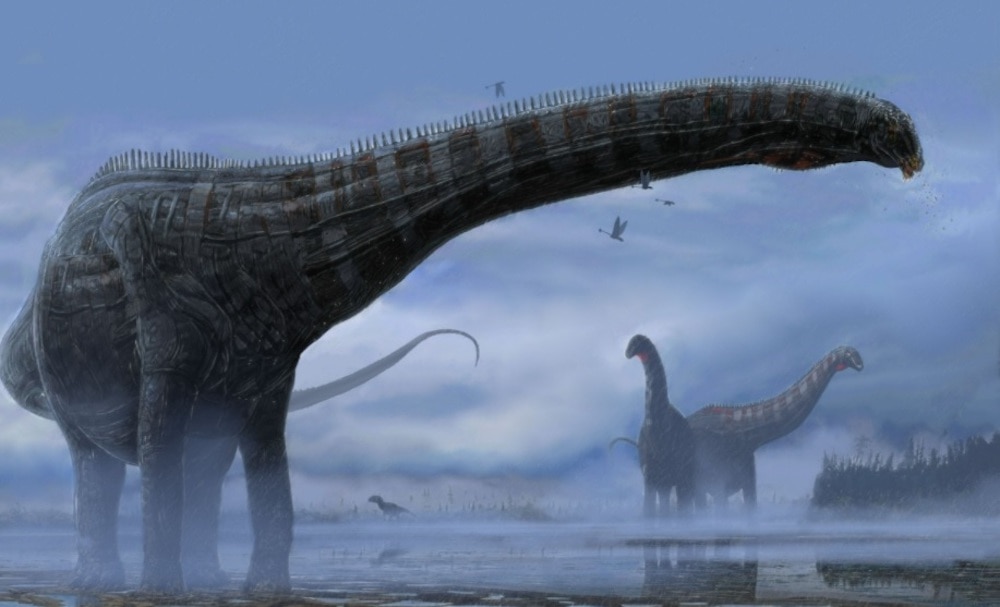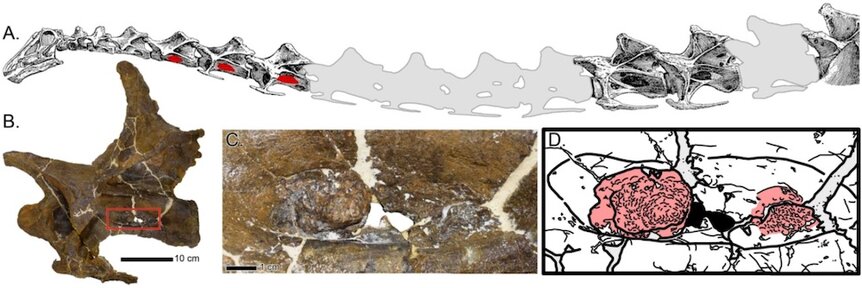Create a free profile to get unlimited access to exclusive videos, sweepstakes, and more!
Sauropod dinosaur had the world’s longest and oldest sore throat
You couldn't make enough cough drops to fix this problem.

During a dig in 1990, a team of paleontologists uncovered the fossilized remains of a sauropod. At first glance, they didn’t notice anything unusual, and the bones were packed up, wrapped for protection, and stored for later cleaning and investigation. Then, roughly two decades later, sauropod specialist Dr. Cary Woodruff entered the picture.
Each summer from 2013 to 2015, Woodruff led a team back to the quarry where they found more bones from the same individual. The specimen, which was named Dolly by the team, is believed to be a subadult diplodocid, having died at 15 to 20 years of age, roughly 150 million years ago. Moreover, the team believes they’ve identified the cause of death as a severe respiratory infection which spread from the soft tissues and into the bones of the neck.
Woodruff works at the Great Plains Dinosaur Museum in Montana and recently authored a paper on their findings published in the journal Scientific Reports. In it, they describe unusual growth along the vertebrae, which indicates a severe and fatal respiratory infection.
“I’ve looked at sauropod vertebrae all over the world and I’ve never seen a feature like this,” Woodruff told SYFY WIRE. “Imagine you could fossilize a piece of cauliflower or broccoli at the interface between the respiratory tissue and the bone.”
The team which investigated Dolly included not just paleontologists but anatomists and veterinarians in order to not only study the skeleton but attempt to diagnose what had happened to the dinosaur in the lead-up to its death. Of course, performing a necropsy on an animal which died 150 million years ago isn’t the easiest endeavor. All of the soft tissues which might usually be helpful have long since decayed away, leaving only the bone for reference.
Luckily, many species of dinosaur, sauropods included, share an ancestral lineage with living birds, and some of their body structures have been preserved in their descendants. Birds have a complex respiratory system which, in addition to lungs, includes a series of air sacs which connect through sockets in the vertebrae. The bones of sauropod dinosaurs have those same features, suggesting they had a comparable respiratory system.
“That’s really neat. The fact that we have these same holes in the bone, and in modern birds the respiratory tissue connects into it, we can hypothesize that non-bird dinosaurs would have had similar respiratory soft tissues connecting into them,” Woodruff said.
With that knowledge in hand, the team looked at the sorts of infections that modern birds get to gain insight into what might have happened to Dolly. Their investigation concluded that Dolly acquired an infection of the air sacs which ultimately spread to the bone.
“There are many things that can cause this sort of infection in birds today, but the most common one is actually a fungal infection. Without medical treatment, they are largely lethal. We suggest that if these fungal infections are the most common in living dinosaurs, evolutionarily that had to come from somewhere. Odds are it was also present in dinosaurs in the past,” Woodruff said.
Whether the infection caused Dolly’s death outright, or simply made them weak enough that they became easy prey for predators is unclear, but Woodruff is confident that in one way or another, the illness eventually led to the dinosaur’s death. Before it ultimately took their life, Dolly must have felt miserable. In order for the infection to spread to the bone, it must first have completely colonized the rest of the respiratory soft tissues, likely resulting in similar growths inside the throat.
We can empathize with how Dolly must have felt. If ever you’ve had a severe cold or flu infection, you might have some inkling of what they underwent.
“Birds that have these infections today express flu or pneumonia-like symptoms. That’s coughing, sneezing, throwing up, headaches, swollen throats, labored breathing, weight loss, pale complexion. It’s all the same symptoms you or I feel with respiratory disorders. You and Dolly shared symptoms 150 million years apart,” Woodruff said.
Being eaten by a predator somehow feels almost ordinary for a dinosaur, easy to imagine. But there’s something about suffering from illness which is universal and allows us to travel back more than a hundred million years in our minds and really feel what it must have been like.
Unfortunately, no one could give the sick sauropod a warm bowl of chicken soup to soothe their rough throat. Dolly’s surviving relatives wouldn’t become chickens for millions of years.



























